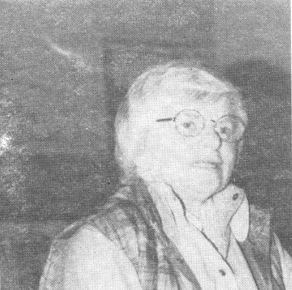THE BODHI STAND
INTRODUCES
UPASIKA KUO SHENG KRIEGER
Dr.
Dolores Krieger, a registered nurse and professor of nursing leads a
dynamic life full of countless experiences, the richness and import of
which she gladly shares with the same joy of giving that marks her
teaching and acts of healing. Throughout her life she has especially
explored Eastern thought and has felt deep affinities with the Bodhisattva
of Great Compassion, Kuan Yin.
As
a Professor of Nursing at New York University, Dr. Krieger began her
post-doctoral nursing research about eight and a half years ago. Of this
she relates:
This
research has been concerned with what I have come to call therapeutic
touch, but which has been traditionally known as the laying-on of hands.
It is a uniquely human act of concern of one individual for another which
is characterized by the touching of one by another in an act that
incorporates an intent to help or to heal the person so touched. To be
truly therapeutic, I feel that this act must be deeply motivated in the
best interests of the person who is touched. I also feel that the person
doing the touching must be educable, for although the act seems quite
simple, almost casual, it is in fact quite complex and the toucher must be
able to understand the underlying dynamics of these complexities. He must,
for instance, be able to learn to recognize certain cues to subtle levels
of consciousness so that he might be intelligently aware of the processes,
conscious and unconscious, which he may set in motion, and he must be able
to develop the insight to recognize whose needs he is meeting by giving
himself to this mode of therapeutics, the patient's needs or those that
buttress his own ego structure. Therapeutic touch, I believe, is a tool
frequently used by nurses in their care of patients, either knowledgeably
or unconsciously. My feeling has been that as nurses we are responsible
for our nursing acts and, therefore, it behooves us to understand the
basis for this particular mode of therapeutics as well as we would
understand the underlying dynamics of any pharmaceuticals we might give,
or any other procedure in which we might engage ourselves as nurses.
Her
research of available material, both Eastern and Western, ancient and
modern lead Dr. Krieger to the speculative conclusion that the hemoglobin
values of patients would change following treatment by therapeutic touch
whereas the hemoglobin values of comparable patients not treated by
therapeutic touch would demonstrate no significant difference after a
similar period of time. She then set about to test this hypothesis with
feasibility studies involving therapeutic touch within a framework bound
by valid scientific methodologies. The studies gave high proof of the
accuracy of her hypothesis.
Interestingly,
there were criticisms to her first studies because she did not control for
two things: meditation and breathing exercises. Studies by her
contemporaries were revealing that meditation has a significant effect on
certain physiologic variables, such as a reduced heartbeat, respiratory
rate, oxygen consumption, carbon dioxide elimination, blood lactate and
blood pressure. The suggestion was that meditation might also effect
hemoglobin values. The same criticism was offered regarding breathing
exercises, which are known to increase the hemoglobin value. Dr. Krieger,
feeling this criticism was valid, entirely repeated her studies
controlling for these two aspects as well. The validity of her findings
still held.
After
concentrated work with healers and the act of healing in her
experimentation. Dr. Krieger began to grow curious about the process
itself and learned how to do therapeutic touch under the tutelage of Dora
Kunz. Of this Dr. Krieger says,
In
time I found that I was able to elicit similar reactions in the patient as
are stated in the literature; specifically, that the patient would feel
heat within the tissues underlying the area upon which I had my hands,
they would feel profoundly relaxed and have a sense of well being. It
occurred to me that since I was able to do this that rather than this
being something only a few chosen people could do, perhaps it was a
natural potential in man which could be actualized under the conditions
mentioned above, i.e., the person having an intent to help or to heal,
being constructively motivated in his intention, and being educable.
In
recent years Dr. Krieger has tested this notion with students of nursing
at New York University. After attaining proof of her hypothesis through
controlled studies. Dr. Krieger proposed to the Dean's Coordinating
Council of New York University a graduate course at the Master's level
which is designed to formally teach the process of therapeutic touch and
develop theory concerned with its underlying bio-energetics and
psychodynamics to graduate students within the Division of Nursing. Her
proposal was accepted and the courses began two years ago. More recently,
Dr. Krieger has been invited to conduct workshops on therapeutic touch by
hospitals, universities, schools of medicine and nursing and professional
medical groups throughout the world.
Her
extensive travels brought her last March to the City of Ten Thousand
Buddhas where she met the Venerable Master and the members of the
four-fold assembly for the first time. After that initial meeting, Dr.
Krieger renewed contact with the Master and the Sangha and lay-people of
the Sino-American Buddhist Association whenever her travels would permit.
Six months after her first meeting. Dr. Krieger took refuge with the
Triple Jewel, bowed to the Master as her teacher, and was given the Dharma
name, Kuo Sheng "Fruit of Sage-hood."
Now,
one year after her first visit to the City, Kuo Sheng has this to say:
|
